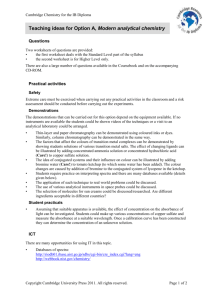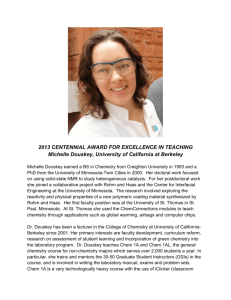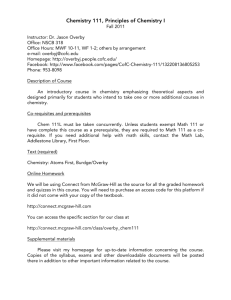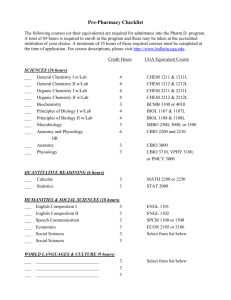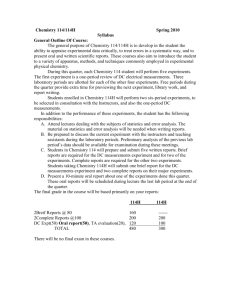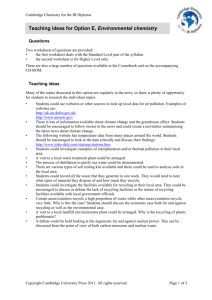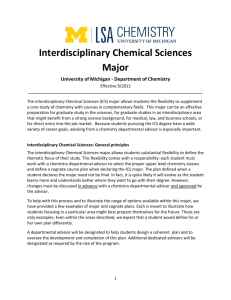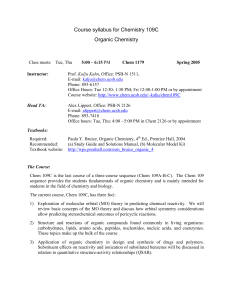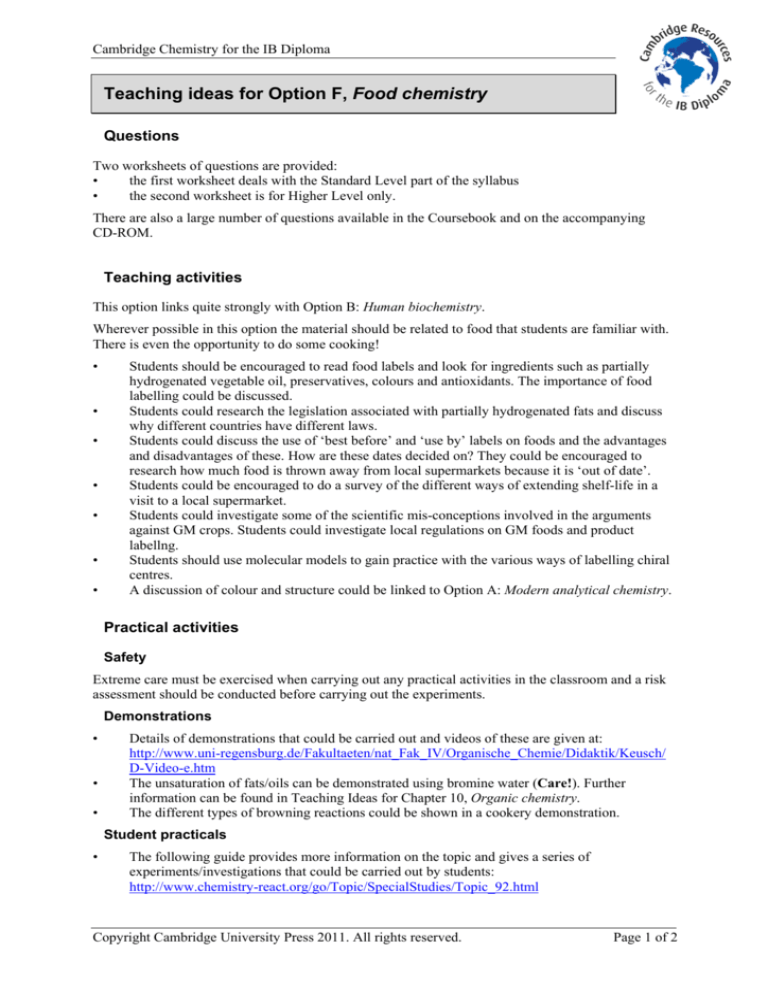
Cambridge Chemistry for the IB Diploma
Teaching ideas for Option F, Food chemistry
Questions
Two worksheets of questions are provided:
•
the first worksheet deals with the Standard Level part of the syllabus
•
the second worksheet is for Higher Level only.
There are also a large number of questions available in the Coursebook and on the accompanying
CD-ROM.
Teaching activities
This option links quite strongly with Option B: Human biochemistry.
Wherever possible in this option the material should be related to food that students are familiar with.
There is even the opportunity to do some cooking!
•
•
•
•
•
•
•
Students should be encouraged to read food labels and look for ingredients such as partially
hydrogenated vegetable oil, preservatives, colours and antioxidants. The importance of food
labelling could be discussed.
Students could research the legislation associated with partially hydrogenated fats and discuss
why different countries have different laws.
Students could discuss the use of ‘best before’ and ‘use by’ labels on foods and the advantages
and disadvantages of these. How are these dates decided on? They could be encouraged to
research how much food is thrown away from local supermarkets because it is ‘out of date’.
Students could be encouraged to do a survey of the different ways of extending shelf-life in a
visit to a local supermarket.
Students could investigate some of the scientific mis-conceptions involved in the arguments
against GM crops. Students could investigate local regulations on GM foods and product
labellng.
Students should use molecular models to gain practice with the various ways of labelling chiral
centres.
A discussion of colour and structure could be linked to Option A: Modern analytical chemistry.
Practical activities
Safety
Extreme care must be exercised when carrying out any practical activities in the classroom and a risk
assessment should be conducted before carrying out the experiments.
Demonstrations
•
•
•
Details of demonstrations that could be carried out and videos of these are given at:
http://www.uni-regensburg.de/Fakultaeten/nat_Fak_IV/Organische_Chemie/Didaktik/Keusch/
D-Video-e.htm
The unsaturation of fats/oils can be demonstrated using bromine water (Care!). Further
information can be found in Teaching Ideas for Chapter 10, Organic chemistry.
The different types of browning reactions could be shown in a cookery demonstration.
Student practicals
•
The following guide provides more information on the topic and gives a series of
experiments/investigations that could be carried out by students:
http://www.chemistry-react.org/go/Topic/SpecialStudies/Topic_92.html
Copyright Cambridge University Press 2011. All rights reserved.
Page 1 of 2
Cambridge Chemistry for the IB Diploma
•
Students could determine the iodine number of a particular fat – see Option B, Human
biochemistry.
Students could extract colouring matter from substances and investigate their
properties:
–
anthocyanin extraction
http://www.crscientific.com/newsletter10-anthocyanins.html
http://www.chemistryland.com/CHM107Lab/Lab1/Lab1PreparingCabbageExtract.htm
http://scifun.chem.wisc.edu/homeexpts/acidbase.html
http://www.chem.umn.edu/services/lecturedemo/info/Cabbage_Indicator.html
–
chlorophyll/carotenoid extraction
http://facstaff.bloomu.edu/mpugh/Experiment2.pdf
http://vohweb.chem.ucla.edu/voh/classes%5CWinter09%5C14CLID9%5CSpinach
PigmentsAssignment.pdf
http://courses.chem.psu.edu/chem36/Chem36H/36H%20Web%20S'05/Chlorophyll%20T
LC.pdf
Students could investigate the properties of colloids, e.g.
http://www.gpb.org/files/pdfs/gpbclassroom/chemistry/solutionsSuspensionsColloidsLab.pdf
•
•
ICT
Some useful websites are listed below.
•
•
•
•
•
•
•
The PubChem database is useful for looking up the structures of complex molecules such as
anthocyanins and carotenoids.
Experiments, teaching notes and videos:
http://www.rsc.org/Education/Teachers/Resources/kitchenchemistry/00_food.htm
GM foods:
http://www.bbc.co.uk/news/uk-politics-11631254
http://fora.tv/2008/11/01/Can_Genetically_Modified_Crops_Feed_the_World
http://www.viddler.com/explore/worldwrite/videos/54/
http://www1.teachertube.com/viewVideo.php?video_id=154338
http://video.google.com/videoplay?docid=-7727700015953778314#
http://jp.reuters.com/news/video?videoChannel=2604&videoId=79112
Databases:
http://pubchem.ncbi.nlm.nih.gov/
http://www.nyu.edu/pages/mathmol/library/
The science of cooking:
http://www.scienceofcooking.com/
R/S assignment:
http://ochem.jsd.claremont.edu/tutorials.htm#
http://chemwiki.ucdavis.edu/Organic_Chemistry/Chirality/Absolute_Configuration,_RS_Sequence_Rules
http://chemistry2.csudh.edu/organic/startnewrands.html
Carotenoids:
http://www.food-info.net/uk/caro/stru.htm
Theory of knowledge (TOK)
As mentioned above, the GM food debate could be discussed. How scientific is the debate?
Copyright Cambridge University Press 2011. All rights reserved.
Page 2 of 2


